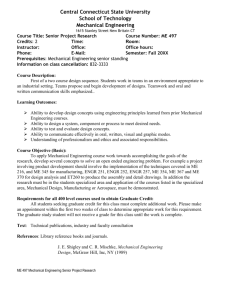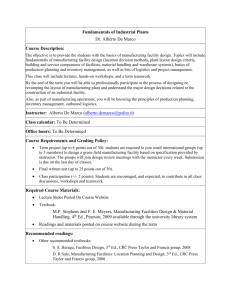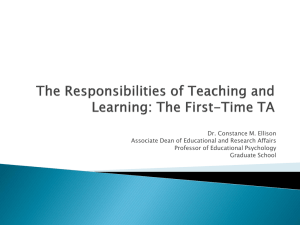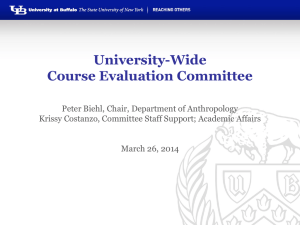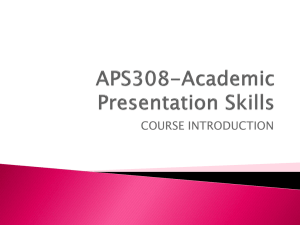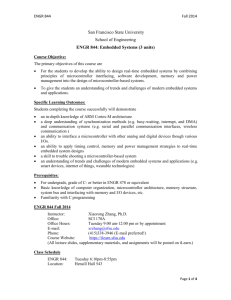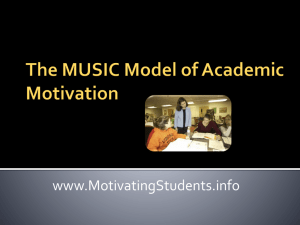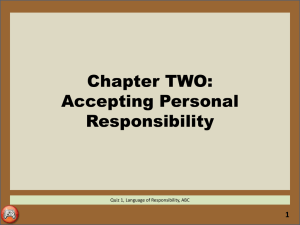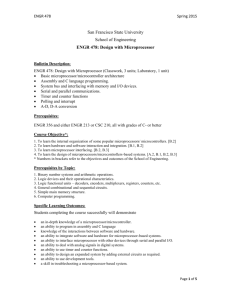How People Learn Engineering
advertisement
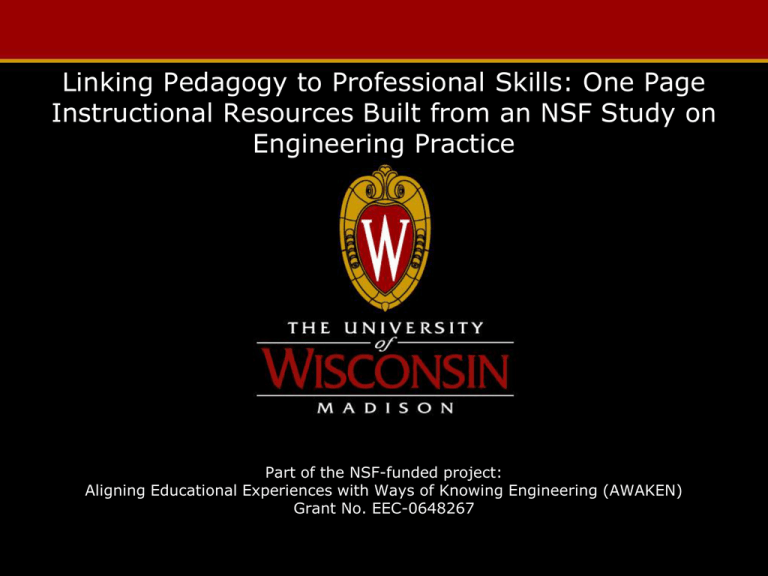
Linking Pedagogy to Professional Skills: One Page Instructional Resources Built from an NSF Study on Engineering Practice Part of the NSF-funded project: Aligning Educational Experiences with Ways of Knowing Engineering (AWAKEN) Grant No. EEC-0648267 Who is here with us? Quick poll – What is your field of study? a) b) c) d) e) Natural Science Physical Science Engineering Mathematics Other Who is here with us? Quick poll, are you a: a) Graduate student b) Faculty c) Academic staff d) Administrator e) Other (write in the others on the slide…) Who we are Presenters: Kevin Anderson & Tom McGlamery NSF Project Team also included: Sandy Courter, Traci Nathans-Kelly & Christine Nicometo Outcomes: You will… • Gain tools for explicitly integrating real-world problem solving and teamwork skills in your courses This study applies across disciplines. • “Essential learning outcomes” are similar across STEM disciplines and institutions. • Intellectual and Practical Skills • Inquiry and analysis • Critical and creative thinking • Written and oral communication • Quantitative literacy • Information, media, and technology literacy • Teamwork and problem solving We wanted an authentic picture of engineering work, thinking, and learning. “Participation in a community of practice involves developing that community’s ways of doing, being, caring, and knowing—and [their] distinct way of thinking … an epistemic frame.” ~David W. Shaffer We use a mixed methodology. Surveys Student Interviews & Essays Case Studies Engineers say that the essential skills in their work are communication and problem solving. 62% Communication skills 57% Solving problems Teamwork 53% Application of ethics 53% 45% Life-long learning 42% Business understanding 0% 20% 40% 60% 80% Engineers value doing and learning new things. 4.9 Solving new problem 4.77 Learning something new Exercising creativity 4.59 Making money for the company 4.58 4.5 Benefit society 4.32 Relationships with clients 4 4.1 4.2 4.3 4.4 4.5 4.6 4.7 4.8 4.9 5 Where are you now? • As an instructor, what do you do now to explicitly engage students in real-world problem solving? Go to the one page report on problem solving. • http://hplengr.engr.wisc.edu/resources. htm Problem solving • How is workplace problem solving different than what is done in the traditional classroom? – Trevelyan (2010) – Jonassen, Strobel and Lee (2006) Problem solving • What are you doing to get freshman involved in real-world problem solving from day one? – Improves retention! Problem solving • Case studies – Article: combines case w/ activity – Center for Case Studies in Engineering • www.civeng.carleton.ca/ECL2/search_cases – Learning from engineering failures • www.engineeringfailures.org – Ethics through case studies • http://www.engin.umich.edu/teaching/assess_a nd_improve/handbook/direct/casestudy.html Problem solving • Model Eliciting Activities – ask students, like practicing engineers, to better understand an open-ended, clientdriven problem by mathematically modeling its parameters. • Yildirim, Shuman and Besterfield-Sacre (2010) IJEE http://www.modelsandmodeling.pitt.edu/Publications_f iles/MEA_Ijee2332_1.pdf Assessing and supporting problem solving • How do you assess problem solving? – Student portfolios of work – Rubric – In class structures for basic problems Most engineering problems are solved in teams. • “Engineering is almost always a team sport. Communicating and working well with others to define and solve problems are fairly important skills.” • “If I have to name two things that can derail a technically competent engineer who works hard, it's the inability to work in teams and inability to effectively communicate.” • What kinds of teams do students form in your discipline and your classes? • What team-related activities are incorporated into your classes? Briefly, here is what we will discuss: I. The culture of individualism that prevails in many classrooms. II. The resulting need students have for help in executing team projects. III.The several different challenges engineering design projects pose. IV. The wide range of approaches engineering faculty take to teaching teams. V. A hybrid approach that balances need for supervision with need for the lessons of autonomy. Though changes are afoot, student culture and work is still highly individualized. • • • • Assignments Activities, including homework Organization of space Tests and Grades • Group presentations • Peer review and group projects • Group tables Students thus need help when undertaking team projects, especially long-term, high-stakes projects. • Inexperienced: • Unprecedented technical, logistical, and social challenges • For some it is their first design experience • For many it is their first semester-long (or longer) project • Their social interactions are more diverse, sustained, and momentous than those required by previous projects. • Resistant: • Accustomed to standing or falling on their own merits • Resentful of circumstances of dependency • Worried because of poor past experiences in teams Social challenges are substantially informed by the difficulty and duration of the project. They include . . . • • • • Conflicting goals and agendas Conflicting judgments Disparate skills and skill levels Client-associated challenges: • Clarifying needs and wants • Communicating constraints • Answering diplomatic challenges • This is not to even broach how team dynamics are complicated by interpersonal relationships and agendas that can develop over the term. • Faculty take widely divergent approaches to supervising their teams. • How much support/direction do you provide to your teams? • What is the nature of that support and direction? • For the purpose of this discussion, let’s reduce faculty approaches to two: • hands-off and hands-on. In the hands-off approach . . . • Teams are assigned and then provided with – a problem to solve (often through design) – deadlines to meet – clients to serve • Interactions with the instructor generally take the form of somewhat infrequent but regular meetings, presentations, or document submissions. Unscheduled consultation is strongly discouraged. • Teams are virtually required, to handle their own logistical challenges and resolve their own conflicts. This approach can especially be appropriate if . . . • Projects are of relatively slight complexity and duration. • Teams are small. • Students are experienced at team projects or have extensive organizational experience. The optimal outcome for this approach is that . . . • The technical, logistical, and social problems are solvable. The project is a success, the students learn not only technical skills but also project and conflict management skills, and the instructor avoids being unnecessarily burdened. But negative consequences can also follow from instructor under-involvement: • Students won’t know “where to start.” • Students make unrealistic schedules and plans. • Students employ ineffective project management tools. • Students have no strategies for managing conflict. • Frustration, time waste, underperformance, and under-learning follow. Clients, too, maybe negatively affected. A more hands-on approach is advised when. . . • Projects are usually lengthy and technically complex. • Teams are large, diverse. • Students may not have much team experience. In the hands-on approach . . . • Teams are assigned and then provided with – a problem to solve (often through design), – deadlines to meet, – clients to serve. • Scheduled meetings are more frequent, and a certain amount of unscheduled consultation is tolerated or even encouraged. • Instructor sets closely scheduled interim deadlines for the teams. Instructor may provide forms for helping teams with self-evaluation, task-scheduling and assignment, etc. • Teams are encouraged to handle their own conflicts, but instructors indicate willingness to be involved when certain thresholds are reached. The optimal outcome for this approach is that . . . • again, the myriad problems are solvable. The project is a success; the students learn a wide range of skills; clients and instructors are happy with outcomes. Over-involvement, of course, denies students ownership and learning opportunities. It also eats up the instructor’s time and energy. A hybrid approach compels students to develop important tools for team management through focused activities. • Conducting a pre-mortem • Developing a team compact • Reading, and being tested upon, materials providing grounding in the following: – – – – – – Opening and maintaining effective communication Planning and running effective meetings Setting and maintaining a realistic schedule Assigning clearly defined roles Making responsible decisions Managing conflict A pre-mortem is an exercise intended to avert what Danial Kahneman has called “The Planning Fallacy.” • The team imagines that their project has failed and provides likely reasons why. • Inventory problems with past team experiences. • Relay word on the street re: challenges posed by the course and project. • What are the common problems you see in your own teams or hear about from colleagues? • How are these problems solved or managed? The compact provides a set of agreed-upon rules and standards for student conduct. 1. Set team goals 2. Stipulate attendance expectations 3. Define acceptable meeting behavior 4. Set acceptable response-time limits for email and other communications 5. Prescribe minimum amount of time members should devote each week to project. The compact provides several important benefits: 1. It provides the team with a focused initial task that yields a framework for later work. 2. It helps the team identify and avoid potential pitfalls. 3. It provides an important accountability mechanism. We also recommend that the instructor perform an induction interview comprising the following: 1. Justifying the team pedagogy and associated activities 2. Previewing hardship for the teams 3. Projecting successful outcomes Here are some resources you may find valuable: http://www.foundationcoalition.org/home/ke ycomponents/student_teams.html http://ocw.mit.edu/courses/sloan-school-ofmanagement/15-279-managementcommunication-for-undergraduates-spring2005/lecture-notes/ https://engineering.purdue.edu/CATME You can also go to our one page report on teamwork. • http://hplengr.engr.wisc.edu/resources. htm Final Q&A Do you have any final questions or comments for the group or the presenters? Thank you for joining us! For further information you may also visit our website: http://hplengr.engr.wisc.edu Kevin Anderson: kevin.anderson@cesa2.org Tom McGlamery: mcglamer@engr.wisc.edu Funded by NSF Grant No. EEC-0648267
